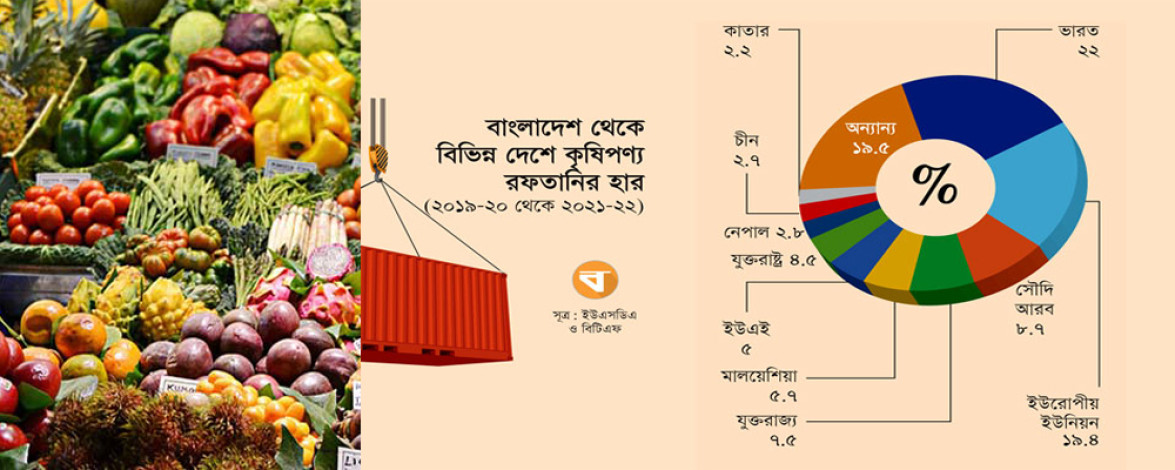
Photo: Collected
Among the least developed countries (LDCs), the African countries in terms of agricultural exports are Eritrea, Angola, the Central African Republic, and Guyana in South America. After this is the position of Bangladesh. That is, the contribution of agricultural products to the export income, Bangladesh is one of the last five countries in the list. In the last financial year (2021-22), the country exported more than 52 billion dollars worth of goods. Of this, agricultural and fishery products were worth 1.7 billion dollars. That is, the contribution of agricultural products to the total export is only 3.3 percent. This information has been highlighted in the research report titled 'Implications of LDC Graduation for Agricultural Exports from Bangladesh: Issues and Policy Options' published by the United States Department of Agriculture (USDA) and Bangladesh Trade Facilitation (BTF).
Bangladesh gets LDC benefits in terms of exports to different countries. Many countries do not have to pay any kind of duty. However, in 2026, the tariff rate will be added to the case of Bangladesh after transitioning from the least developed country. Analysts believe that this will have a negative impact on the overall export as well as on the export of agricultural products. Therefore, it is important to take initiatives to improve the productivity of agricultural products as well as to maintain their quality. Otherwise, they said that after the transition of LDC, there will be concern about the survival of the competition in the international market.
This was discussed with Mohammad Abdur Razzak, Chairman of Policy Integration for Development (RAPID), who conducted the study. He said, "We have conducted the research only on what effect the transition of LDC can have on agricultural exports." Although our agricultural exports are low. After the transition of LDCs, the competition in the field of exports will increase a lot. That is why we need to increase our capacity from now on. Increase productivity and improve quality. We have many products but cannot export to foreign markets due to lack of good quality. We have to prepare for this from now.
Abdur Razzak also said, "Our position in agricultural exports is very low among underdeveloped countries. There is a reason for this. A major part of our total exports comes from ready-made garments. Other countries do not come that way. Their exports are largely agricultural. Due to this, the rate of agriculture in the total export is low.
According to a USDA research report, Bangladesh exports agricultural products to more than 160 countries. Although more than half of it is exported only to India, European Union, and Saudi Arabia. Most of these agricultural products are sent to neighboring India. In the three years from 2019-20 to 2021-22 financial year, the country exported 22 percent of the total agricultural produce. In addition, 19.4 percent of exports are to European Union countries, 8.7 percent to Saudi Arabia, 7.5 percent to the United Kingdom, and 5.7 percent to Malaysia. In addition, 5 percent of exports are to the United Arab Emirates, 4.5 percent to the United States, 2.8 percent to Nepal, 2.7 percent to China, 2.2 percent to Qatar, and 19.5 percent to other countries.
The report also says that Bangladesh, being a less developed country, gets tariff benefits for exports to various countries. But after the transition from LDCs, new tariff rates will be added to exports to these countries. In this case, the tariff rate will be added by 11 percent in India, 20.2 percent in Japan, 2 percent in Canada, 3 percent in the United Kingdom, 4.65 percent in South Korea, 6 or 10 percent in European Union countries, and 10 percent in China. This may reduce exports from 5.8 percent to 11.1 percent to the seven countries where most agricultural products go from Bangladesh.
According to the research report, in the three years from 2019-20 to 2021-22 fiscal year, the average export of agricultural products in seven countries was 482.45 million dollars. However, the export of agricultural products may decrease from 26.3 million dollars to 53.71 million dollars due to the increase in tariff rates after the transition of LDC. Of this, exports to India may decrease by 21 to 43 million dollars, which is 11 to 9 percent of the total export earnings of the sector.
The research report was released at the workshop titled 'Impact and Actions of LDC Graduation in Agriculture Sector' organized by the Department of Economic Relations in the capital's Tourism Building Auditorium yesterday. There, the Minister of State for Planning. Shamsul Alam said, "After the passage of LDC, the export volume may decrease, as the price will increase. Many benefits will also be added. LDC graduation will take us a long way. Subsidy in agriculture has the scope to go up to 10 percent of GDP. Now there is only 1.3 percent.
Agriculture Minister Mohammad Abdur Razzak said, "As an underdeveloped country, we get several benefits in terms of exports to European countries or other countries. But LDC transition is not expected to affect exports as much. We have to rise to the challenge. Safe food must be produced. Different countries want to have safe food. Therefore, there is an opportunity to export food products to different countries. The minister also said, "Many things are involved in exporting." We provide incentives for agricultural exports. It will continue. All necessary facilities will be provided to make agriculture export-oriented. At the same time, various steps are being taken to encourage local production. In terms of exports, the potential of agriculture should be utilized.
Source:
Online/GFMM
Comment Now